Sample marketing plan for online higher education
When we got deeper into the data, we saw that the higher education industry is overly reliant on certain digital marketing channels. A good marketing campaign addresses the full funnel. To attract students, you must increase search engine visibility, maintain a strong social media presence, and ensure you’re doing all you can to target prospective students.
So, with all the great tactics and technologies to attract prospective students (virtual campus tours, student ambassadors, and taking advantage of digital technology to highlight student activities), one has to wonder why other higher ed institutions seem to be attracting more new students.
As I’m sure you’re aware, Google and the other search engines know everything, right? So, I thought, why not let Google guide me? I wanted to see how other higher ed marketers were thinking about the strategy to build brand awareness and get in front of prospective students.
I think it’s important to take content created by marketers talking about a marketing strategy with a grain of salt. We can, however, learn a lot when we analyze the frequency with which these articles cite specific tactics, platforms, or strategies to get in front of prospective students for educational institutions.
Effective Higher Education Marketing Strategies
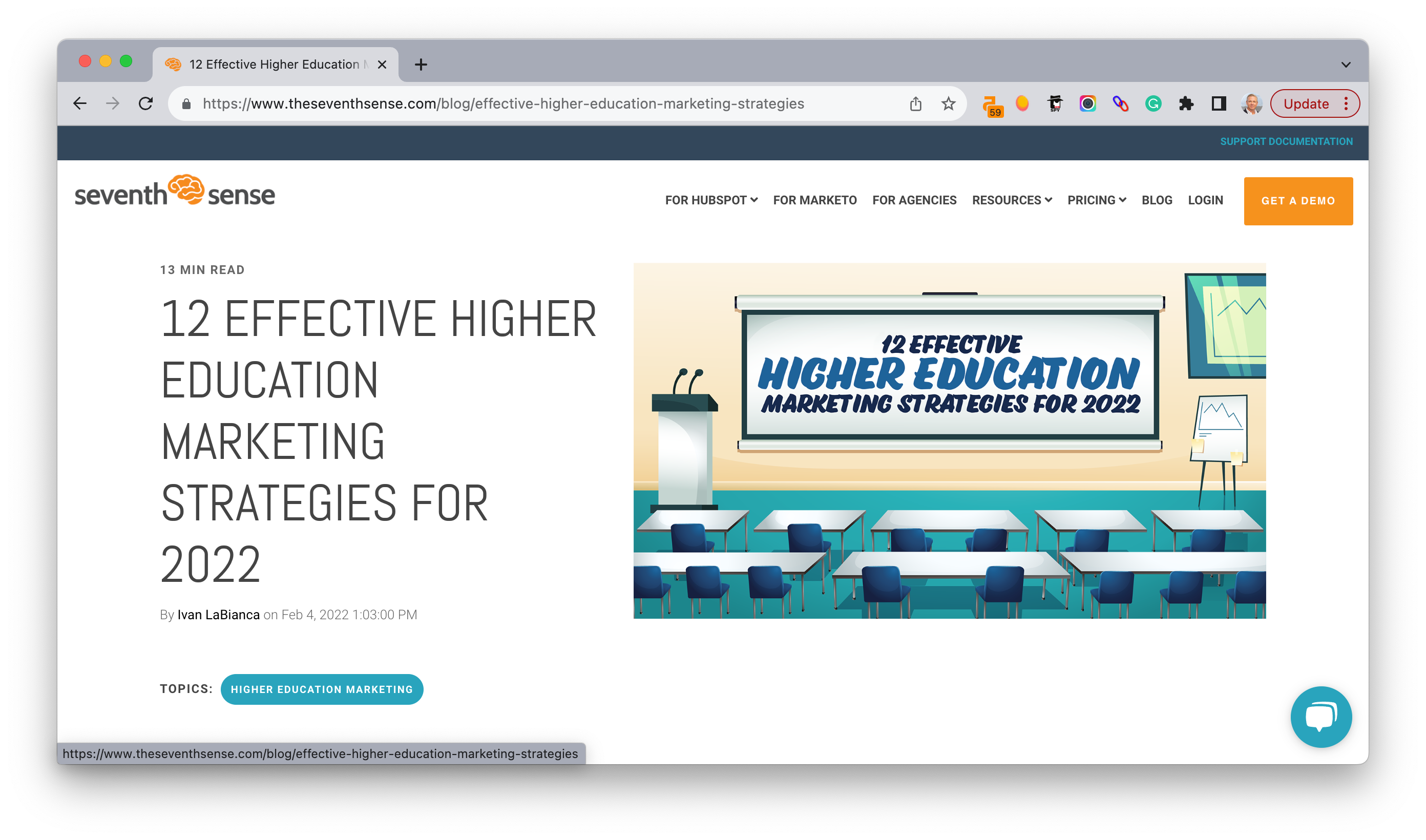
My perspective: It’s surprising to see this continued focus on the pandemic. From what we’ve seen, things are different — the pandemic is done in most people’s minds, and we’re now in the “new normal.”
The article discusses the challenges faced by university marketers due to the pandemic and the downturn in undergraduate student enrollment. It provides 12 strategies for higher education marketing:
- Centralize Strategy and Reporting: Emphasizes the importance of centralizing marketing expenditures and standardizing KPIs.
- Track the Right KPIs: Highlights the importance of tracking call-to-action conversion rates, traffic sources, social media engagement, and cost of acquisition.
- Use Marketing Automation: Discusses the benefits of tracking digital interactions with prospective students.
- Optimize Your Email Program With AI: Offers email deliverability and engagement solutions.
- Improve SEO: Stresses the importance of using relevant keywords and answering prospective students’ queries.
- Build a Digital-Friendly Brand: Talks about updating branding to be more digital-friendly.
- Live Streaming: Suggests using live streams as an authentic way to connect with potential students.
- Personalized Communication: Emphasizes the importance of segmenting audiences and tailoring communication.
- Higher Education Marketing on Social Media: Provides various strategies to maximize social media efforts.
- Personalized Mobile-Friendly Website: Highlights the importance of a responsive and personalized website.
- Chatbots for Higher Education Marketing: Discusses the benefits of using chatbots for immediate responses.
- Don’t Forget Visuals and Aesthetics: Emphasizes the importance of appealing visuals for the Gen Z audience.
Unique Positions:
- The article emphasizes the importance of data-driven strategies, especially in the context of the challenges posed by the pandemic.
- It highlights the significance of understanding and catering to the preferences of Gen Z, who are the next in line for higher education.
Conclusion: The article concludes by emphasizing that marketing shouldn’t be stagnant but should evolve with the university’s overall goals.
Higher Education Marketing: Strategies and Trends to Know
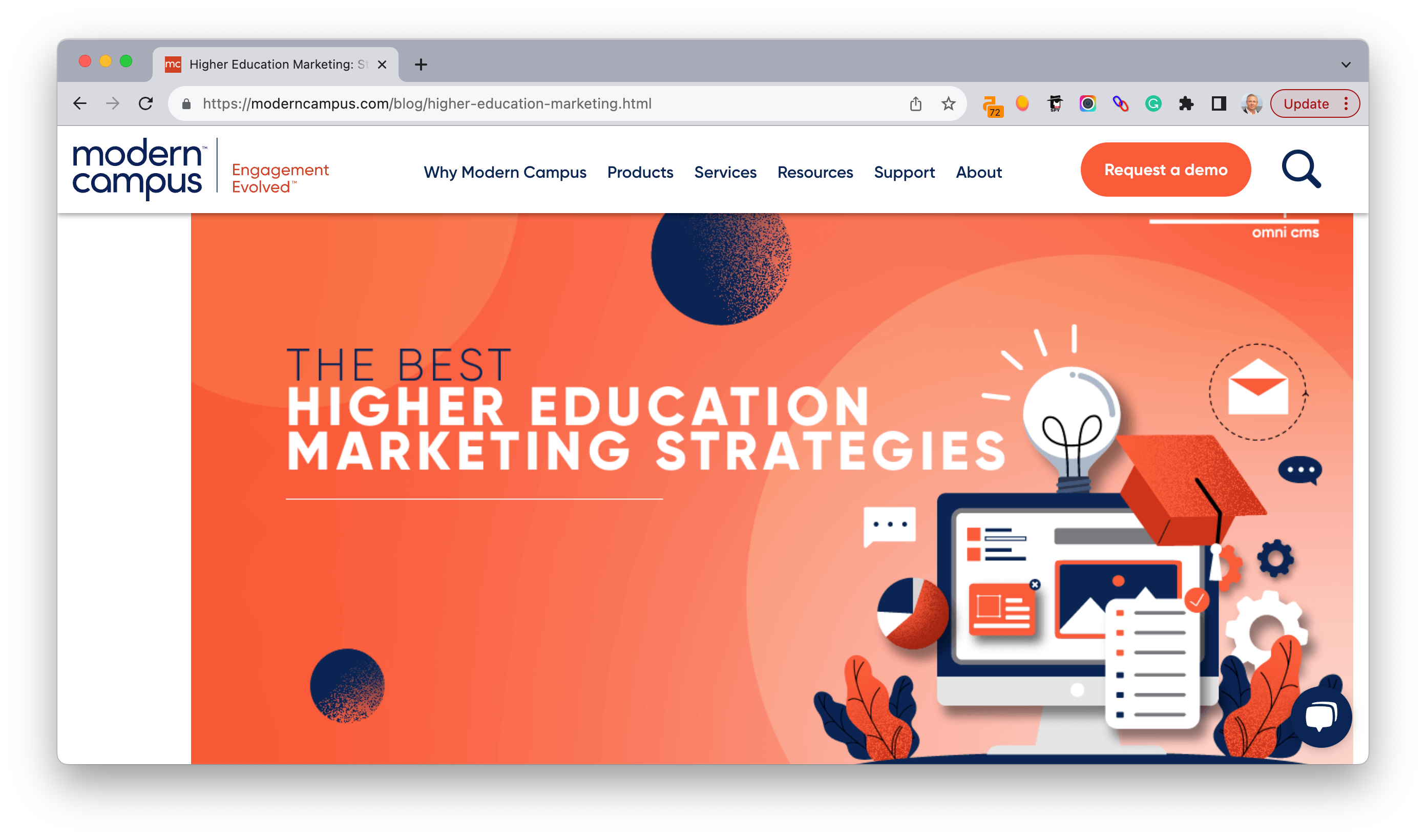
My perspective: It’s interesting to see a focus on the rise of Instagram. TikTok is more timely and clearly the place where Gen Z and beyond are starting their product experiences.
The article emphasizes the importance of refining marketing strategies for higher education institutions, especially in light of decreasing college enrollments.
It provides insights into current higher ed trends and offers strategies to enhance student recruitment.
Key Questions for Your Higher Education Marketing Plan:
- Identifying target audience and personas.
- Determining KPIs for engagement.
- Establishing the cornerstone of the marketing plan.
- Differentiating from other institutions.
Platforms to Market Your Educational Offerings:
- Text messages, especially during the student enrollment process.
- Social media platforms like Twitter, Facebook, LinkedIn, Instagram, and Snapchat.
- Email, direct mail, phone calls, and websites.
Higher Education Marketing Strategies:
- Use a CMS Built for Higher Education: Implement a quality web content management system (CMS) tailored for educational institutions to address challenges like outdated content, complicated coding, inconsistent branding, and low search rankings.
- Get Current Students Involved: Engage existing students to provide authentic insights into campus life.
- Choose a CMS With an Email Module: Emphasizes personalized and targeted email marketing.
- Focus on Video Content: Highlights the importance of integrating video content into marketing strategies.
- Keep Track of Your Brand: Monitor the digital image and reputation of the institution.
- Use the Power of Social Media: Utilize a mix of social media platforms for effective messaging.
- Use Videos and Images on Social Media: Emphasizes the growing preference for visual content on platforms like Instagram, YouTube, and TikTok.
- Personalize at Scale: Deliver personalized content across various platforms.
- Include SEO and Conversion in Your Program Pages: Optimize program pages for search engines and conversions.
- Target Parents: Recognize the influential role of parents in students’ college decisions.
Unique Positions:
- The article underscores the importance of authenticity, especially when involving current students in marketing efforts.
- It highlights the shift in the relevance of different social media platforms, noting the rise of Instagram and the decline of Facebook in the context of college planning.
Conclusion: The article concludes by emphasizing the significance of a quality website and the potential of a CMS to fine-tune a college or university’s marketing strategy.

Analyzing Effective Higher Education Marketing Strategies
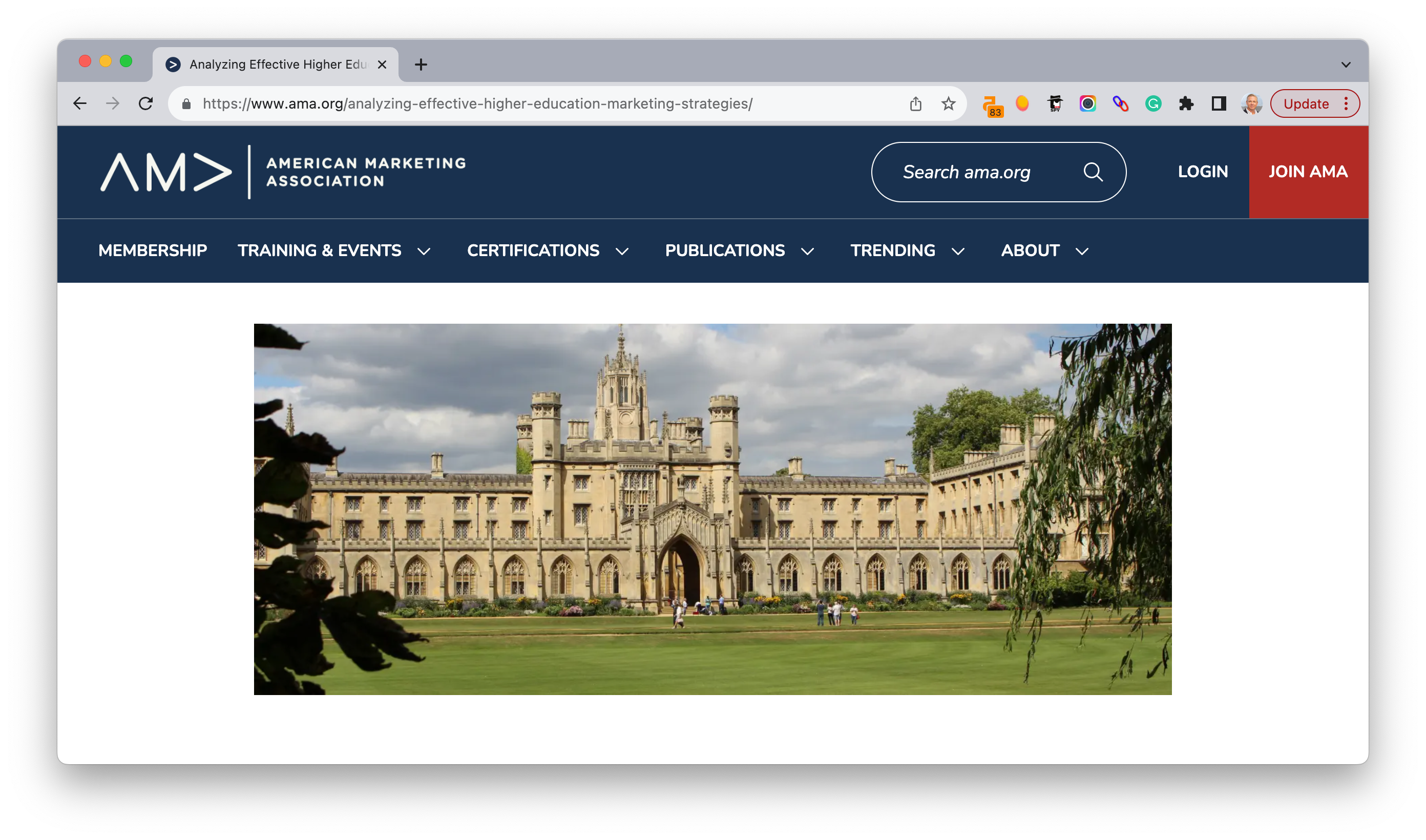
My perspective: I wonder if the author’s suggestion of the value of traditional marketing is pandering to the old guard. Sure, brochures, commercials, etc., may appeal to the parents, but the students are on social media and search.
The article delves into the unique challenges of marketing in the higher education sector, emphasizing the need for institutions to create a superior academic environment while facing intense competition.
It underscores the importance of an effective marketing strategy blending traditional and digital methods to achieve institutional goals.
Why Is it Important to Prioritize Marketing?
- Higher education institutions need to maximize enrollment and diversify their student and faculty demographics.
- They must cater to various stakeholders: students, parents, faculty, and donors.
Traditional Marketing in Higher Education:
- Print: Newspaper or magazine ads, billboards, and stationery.
- Mail: Targeted ads, imagery, and product samples.
- Radio: Over-the-air ads, jingles, and testimonials.
- Television: Video ads, customer reviews, and product demonstrations.
- Unique Assets: Campus tours and visits, research and development, arts, music, and sports.
Digital Marketing Strategies:
- Email Marketing: Deliver branded messages, newsletters, and offers.
- Social Media Marketing (SMM): Disseminate content across channels and engage with influencers.
- Content Marketing: Use blogs, podcasts, videos, etc., to enhance branding.
- Search Engine Optimization (SEO): Enhance online presence and search engine ranking.
- Search Engine Marketing (SEM): Utilize paid placement and digital ads.
- Pay-Per-Click (PPC): Cost-effective advertising where payment is made only when the ad is clicked.
Ideal Marketing Strategy for Higher Education:
- Blend traditional and digital methods.
- Maintain a dynamic website showcasing institutional value.
- Engage in SEO and SEM efforts.
- Execute a comprehensive digital advertising strategy.
- Implement a multifaceted SSM plan.
- Produce diverse content across various media.
- Secure advertising spots in local, regional, and national media.
- Leverage unique assets like research, campus visits, arts, music, and sports.
- Highlight notable faculty and alumni.
Unique Positions:
- The article emphasizes the two-way nature of digital marketing, allowing institutions to have meaningful conversations with interested parties.
- It suggests that, while traditional marketing methods remain relevant, digital marketing has taken precedence in the modern age.
Conclusion: The article concludes by promoting the benefits of joining the American Marketing Association (AMA) for institutions looking to elevate their marketing strategies.

The Ultimate Guide to Higher Education Marketing Strategies
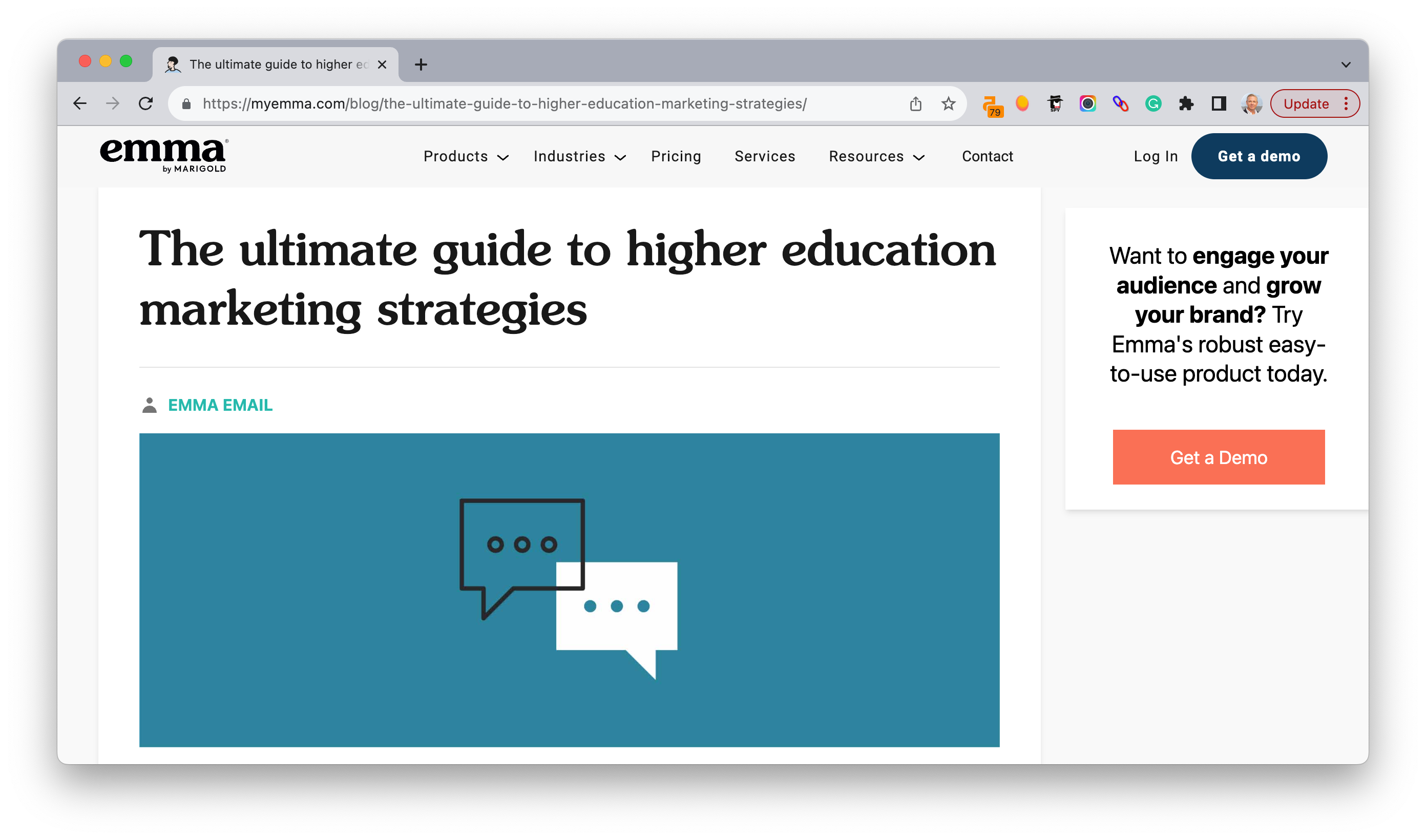
My perspective: Ultimate is a bit of a stretch, but I do appreciate the view on good copy and the needs of various university stakeholders, like advancement, athletics, and current students.
The article addresses the challenges higher education marketers face in today’s digital age. It emphasizes the shift from traditional mass marketing methods, like glossy brochures, to more personalized strategies that resonate with modern students.
Defining the Goals of Your Higher Education Marketing Strategies:
- Marketing for Enrollment: With declining enrollments, targeting prospective students and their parents using digital channels is crucial. Strategies include:
- Publishing informational blog posts and podcasts.
- Engaging authentically on social media.
- Collaborating with micro-influencers.
- Creating video content, including live streams.
- Adopting a mobile-first marketing approach.
- Marketing for Advancement: This focuses on building relationships with alumni and friends of the institution, often for fundraising purposes.
- Marketing for Athletics: Promoting athletic programs to boost interest, spirit, and revenue.
- Marketing for Student Involvement: Inform enrolled students about on-campus activities and opportunities.
The Role of Email in Higher Education Marketing Strategies:
- Email marketing offers a high return on investment (ROI) across various aspects of higher education marketing.
- Effective email strategies include automation, mobile-friendliness, relevant content, inclusion of images and videos, and personalization.
Using Segmentation and Personalization for Prospective Students:
- Personalized email subject lines are more likely to be opened.
- Segmentation ensures content relevance, further increasing open rates.
Consistent Branding:
- Emails should maintain consistent branding, using recognizable colors, fonts, and logos.
Killer Subject Lines and Captivating Content:
- Subject lines should be personable, actionable, and unique.
- Content should be relevant and valuable to the reader.
The Importance of Testing:
- A/B testing or split testing is crucial to determine the effectiveness of email campaigns.
- Testing provides data to refine campaigns for optimal results.
Conclusion: Higher education marketing strategies are essential for institutions to overcome challenges and achieve their goals. Email marketing, in particular, is a powerful tool that can be tailored for various purposes, from boosting enrollment to promoting athletic programs. The article emphasizes the importance of personalization, segmentation, and consistent branding in email campaigns to engage and convert recipients effectively.

12 Higher Education Marketing Strategies for 2022
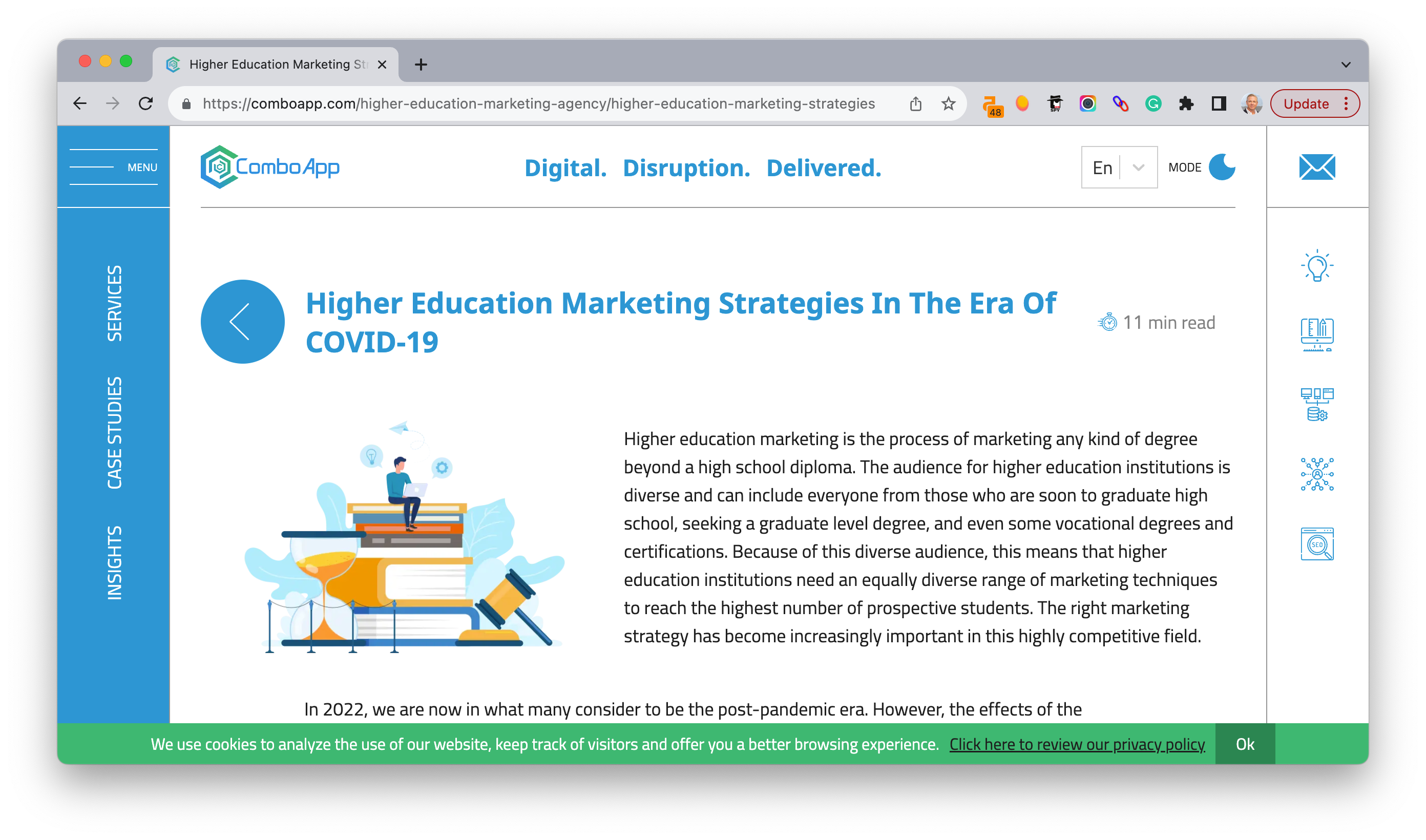
My perspective: I find the idea of marketing “Higher Education” as a concept compelling. I recently had a conversation with one of our summer interns in which he asked, “Do I even need a degree?”
There are definitely fields, like computer science, for instance, where we’re learning that degrees don’t necessarily separate the wheat from the chaff.
The article emphasizes the long-term changes in higher education institutions due to the pandemic, highlighting the importance of distance learning programs, local student outreach, and improved campus safety. It presents 12 techniques for an effective higher education marketing strategy:
- Branding: Focuses on crafting an identity that represents both the school and its student body. Authenticity is key.
- Search Engine Optimization (SEO): Highlights the importance of high rankings on search engines and lists several SEO techniques.
- A Great Website Experience: Stresses the importance of mobile-first design, speed, and ease of use.
- Social Media Marketing: Discusses the significance of authentic engagement on social media platforms, especially for Gen Z and millennials.
- Live Streaming: Emphasizes the use of platforms like Facebook Live, Instagram Live, and YouTube for events, Q&A sessions, and classes.
- Email Marketing: Highlights the preference of students for email communication and the importance of personalization and segmentation.
- Interactive Advertising: Describes the potential of interactive ads, such as games and story-based video ads.
- Leveraging Alumni and Students: Discusses the power of word-of-mouth marketing and the importance of reviews and testimonials from current and former students.
- Distance Learning: Highlights the increasing demand for distance learning options post-pandemic and the opportunities it presents for institutions.
- Pay Per Click Advertising: Discusses the benefits of targeted advertising on platforms like Facebook, Google Ads, and Bing Ads.
- Short-Form Video Content: Emphasizes the importance of platforms like TikTok, Instagram Reels, and YouTube Shorts in engaging potential students.
- Focus on Positive Career Outcomes: Addresses the ongoing discussions about the value of higher education and the importance of showcasing the tangible benefits of a college education, such as high-paying jobs after graduation.
Unique Positions:
- The article stresses the need for institutions to market themselves and the very idea of higher education in light of recent discussions questioning its value.
- It highlights the blend of traditional and modern marketing strategies, emphasizing the importance of authenticity in all communications.
Conclusion: The article concludes by promoting ComboApp as a full-cycle higher education marketing agency that can assist institutions in crafting a comprehensive digital marketing strategy.

8 Higher Ed Digital Marketing Tactics & Trends for 2023
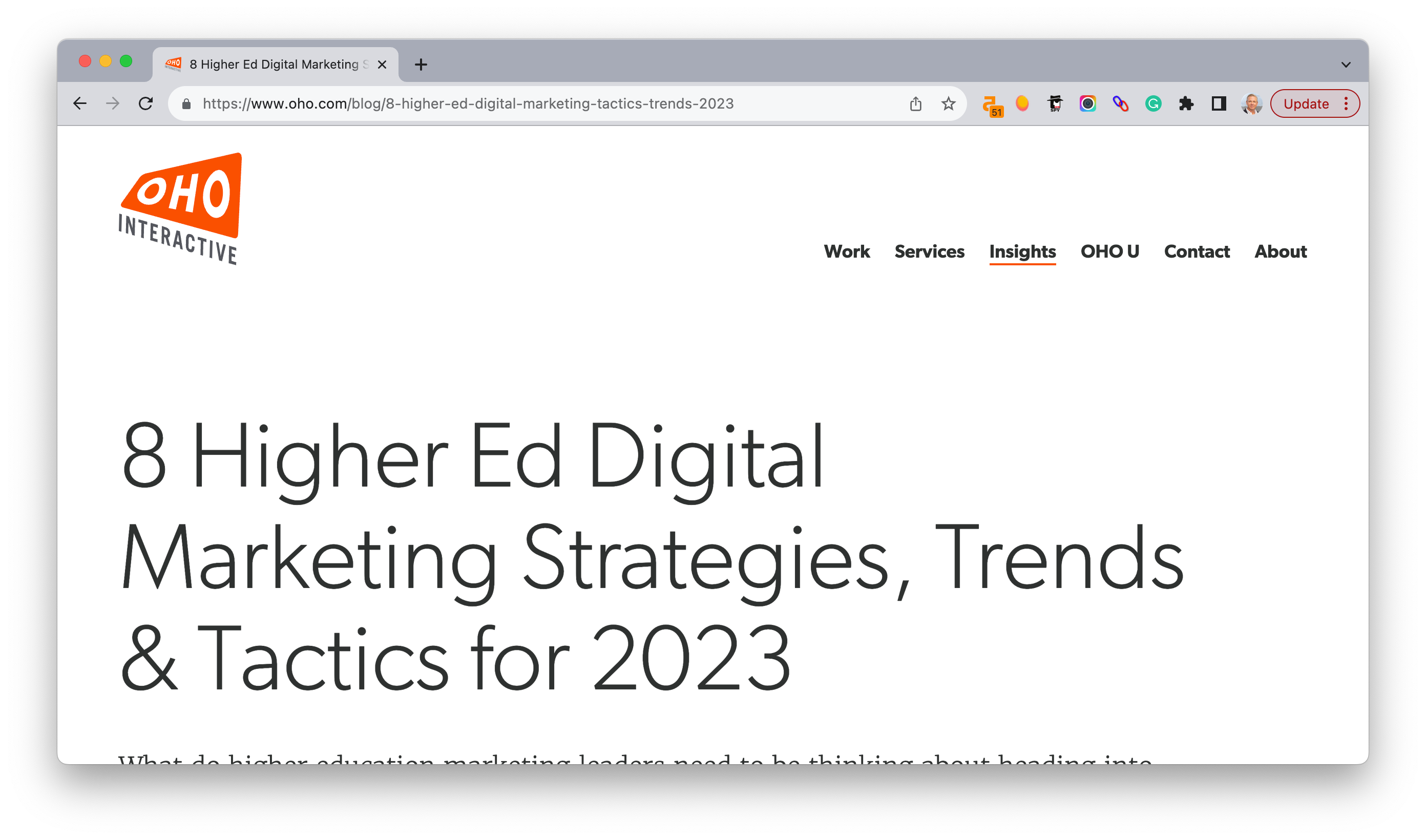
My perspective: Social will continue to be a tremendous way to get in front of future university students. Even though we’re no longer talking about the “Zero moment of truth” (thank goodness), students will continue to be exposed to our schools and programs before they even know they’re looking.
The article sheds light on the evolving landscape of higher education marketing in 2022, emphasizing the need for institutions to adapt to the digital age and the unique preferences of Gen Z.
- Understanding the Crowdsourcing Habits of Gen Z: Gen Z’s decision-making is described as “crowdsourcing,” where they seek opinions from peers, influencers, and reviewers. Institutions should involve them in conversations and connect with their sense of humor, especially on platforms like TikTok.
- Reaching Gen Z With Conversational Marketing: The trend of “conversational marketing” is growing, emphasizing real-time, one-to-one connections to answer questions and assist consumers. University websites should incorporate a human voice and chat opportunities.
- Data Insights Shedding More Light on Higher Ed Audiences: Research indicates that understanding the audience leads to better marketing outcomes. Universities are using CRM systems and other software to analyze the student journey and understand their motivations.
- Growing Emphasis on Personalized Messaging: Digital content engages young people, but they are wary of overt marketing. Personalized, targeted messaging helps universities connect with students and boost conversions.
- Growing Preferences for Short-Form Video: Universities should incorporate short-form videos (around 90 seconds) into their marketing strategies. Examples include video campus tours, answers to FAQs, and student-guided mini-tours.
Unique Positions:
- The article emphasizes the importance of understanding and connecting with Gen Z’s unique preferences, especially their reliance on crowdsourcing for decision-making.
- It highlights the significance of conversational marketing and the need for human interaction, even in the digital age.
Conclusion: The article concludes by promoting Unibuddy, a platform designed for students that offers tools to enhance higher education marketing strategies in line with current trends.
15 Best Marketing Strategies for Universities
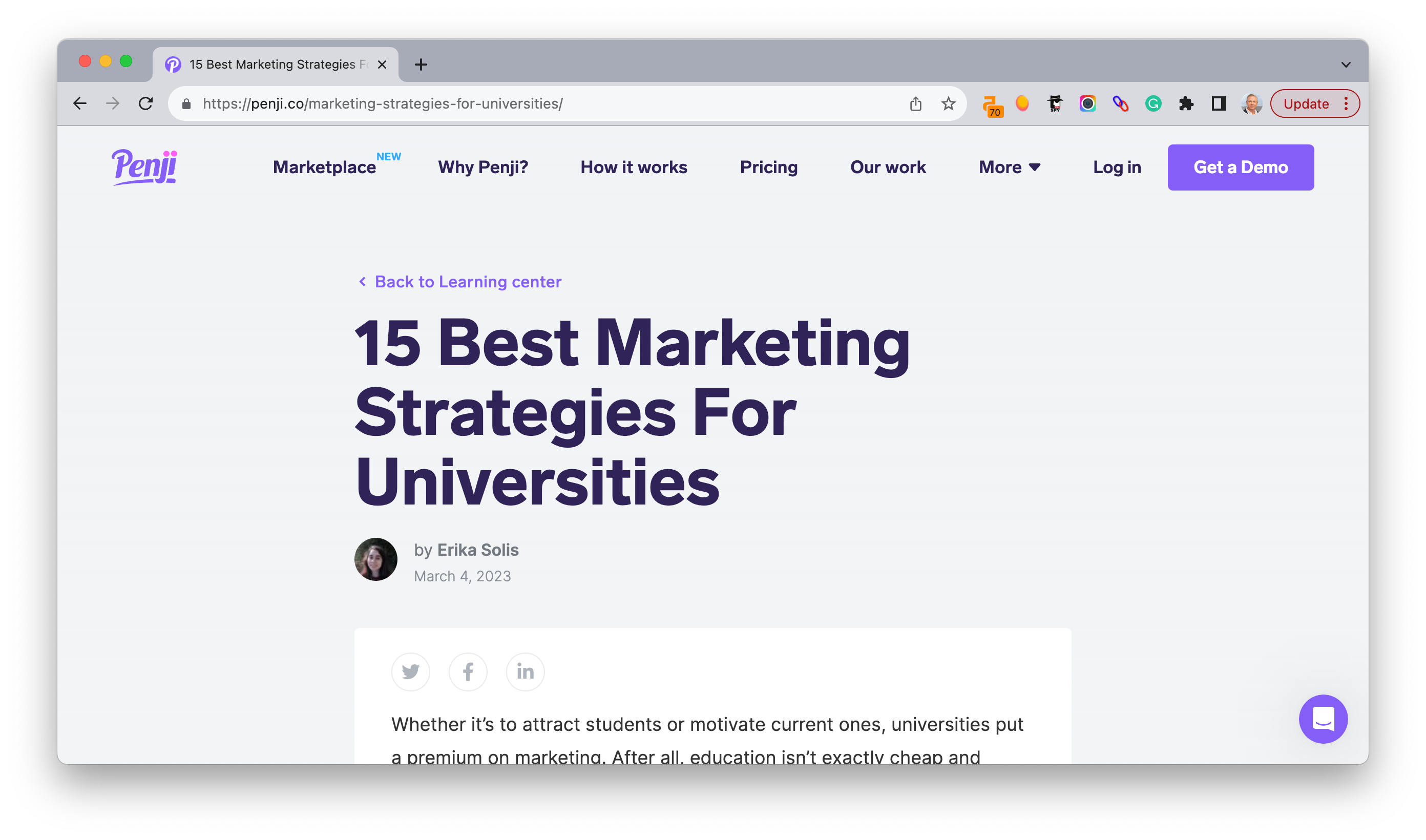
My perspective: It’s not surprising Penji would focus on social and ad creative since they are a marketplace for creative work. I’m not familiar with Penji, but it looks like a new-style iteration of a “99 Designs” concept.
The article underscores the importance of marketing in universities, especially given the competitive nature of higher education marketing. It provides a comprehensive list of strategies to enhance university branding and appeal to a younger audience.
- Social Media: Emphasizes the shift from traditional mail to social media platforms to engage with prospective students. Universities should be present where students are active and ensure their content aligns with the platform’s audience.
- User-Generated Posts: Encourages universities to monitor and engage with content created by students about the institution. This provides insights into the university’s perception and offers opportunities for authentic engagement.
- Define Your Brand Image: Universities should have a consistent voice and image across all marketing channels. This helps in creating a recognizable and trustworthy brand.
- Focus on the Students: Marketing strategies should prioritize the needs and interests of students, both current and prospective. This includes promoting events, assistance, and showcasing the university’s supportive environment.
- Video Marketing on All Platforms: Highlights the increasing importance of short-form video content on platforms like YouTube. Videos offer a dynamic way to showcase campus life, events, and more.
- Statistics: Using data to showcase the university’s achievements, such as high graduation rates, can be a compelling marketing tool.
- Promote Sitting in Classes Before Enrolling: Offering prospective students the chance to experience lectures can help in their decision-making process.
- SEO (Search Engine Optimization): Ensuring the university’s website ranks high on search engines is crucial for visibility.
- Showcase Success: Highlighting the achievements of alumni can serve as a testament to the quality of education provided.
- Embrace Diversity: Marketing campaigns should reflect the diverse student body and cater to non-traditional students as well.
- Use Infographics: Visual representations of data can be more engaging and easier to digest than text-heavy content.
- Paid Traffic: Utilizing paid ads, especially on platforms like Instagram, can help in reaching a wider audience.
- Interactive Webinars: Hosting webinars can provide valuable information to prospective students and give them a taste of the university’s teaching style.
- Downloadable Guides: Offering resources to help students prepare for college can be a valuable tool in the decision-making process.
- Email Marketing: Automated email series tailored to the student’s application process stage can provide personalized guidance.
Unique Positions:
- The article emphasizes the importance of understanding the younger generation’s preferences and adjusting marketing strategies accordingly.
- It highlights graphic design’s role in enhancing marketing campaigns’ effectiveness.
Conclusion: The article concludes by promoting Penji, a graphic design service, as a valuable tool for universities looking to enhance their marketing strategies with quality designs.
16 Effective Digital Marketing Strategies for Higher Education in 2023
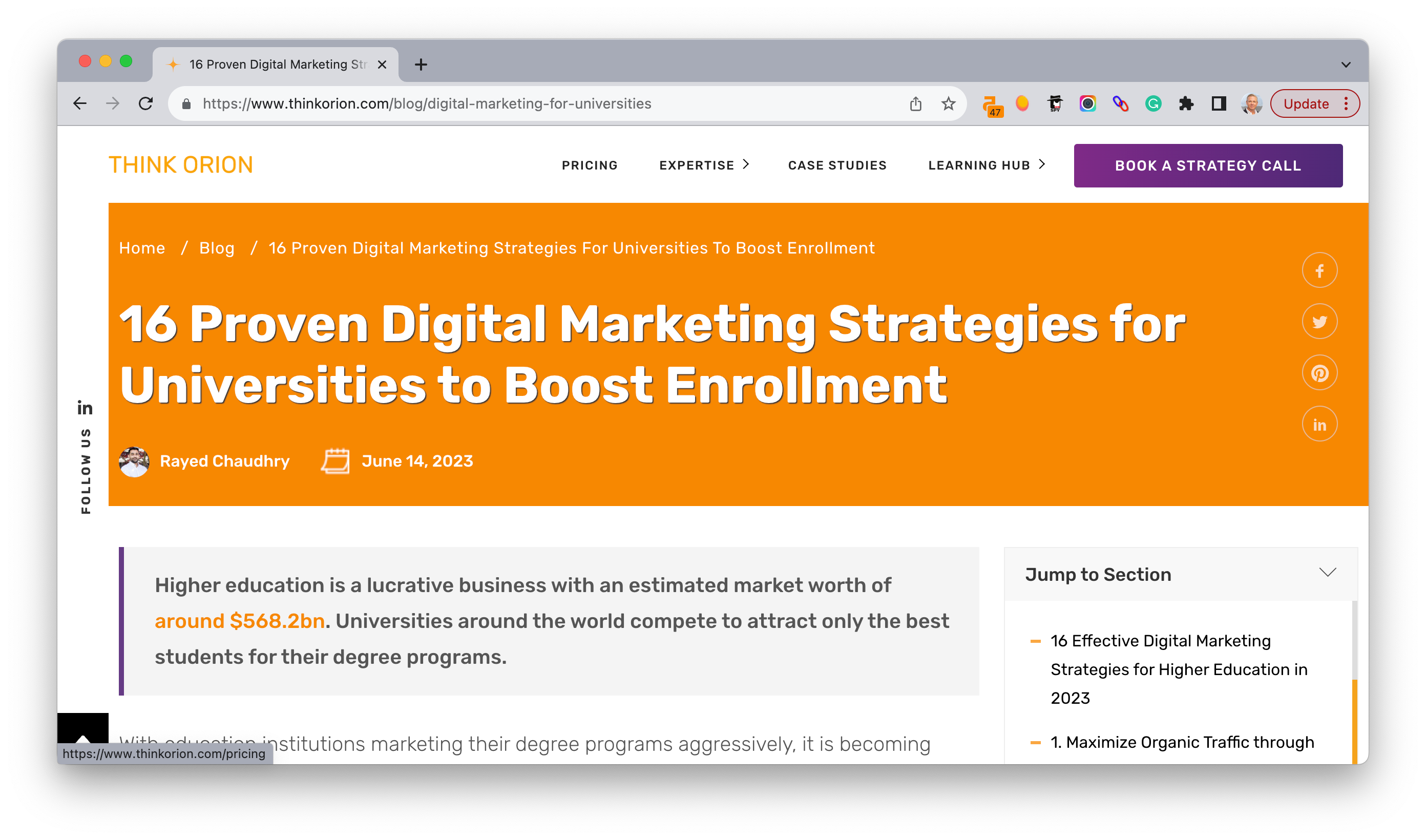
My perspective: I appreciate the focus on real-time and alumni engagement. We’ve been spoiled by instant responses and always on media.
And, students want to know what’s out there after attainment of that degree or certificate. Alumni can help tell this story much better than administrators or (gasp) marketers.
The article delves into the competitive landscape of higher education marketing, emphasizing the importance of standing out to attract the best students. It provides a comprehensive list of strategies to enhance university visibility and appeal:
- Maximize Organic Traffic through Optimized SEO Techniques: Emphasizes the importance of SEO for attracting the right students. It covers aspects like keyword research, internal linking, backlinking, technical audits, and on-page optimization.
- Accelerate Your Sales With Proven PPC Techniques: Discusses the benefits of pay-per-click advertising for promoting university programs and increasing web traffic.
- Attract, Engage, and Retain Students With a Winning Content Marketing Strategy: Highlights the importance of creating engaging and informative content to resonate with potential students.
- Elevate Your Brand Visibility With Google Display Advertising: Discusses the effectiveness of digital display ads over traditional billboard ads, especially on Google’s Display Network.
- Unlock the Power of Social Media: Explores the role of social media platforms like Twitter, Instagram, LinkedIn, and Facebook in connecting with potential students.
- Use Exclusive Email Marketing Campaigns to Promote: Emphasizes the continued relevance of email marketing, stressing the importance of personalization and using AI-powered email programs.
- Make Informed Decisions With Advanced Analysis and Tracking: Discusses the importance of setting specific tracking goals beyond what Google Analytics provides.
- Utilize Video Marketing to its Fullest Potential: Highlights the engagement potential of video content, both in long and short formats.
- Inspire Student Success With Real-Life Stories: Advocates for sharing student success stories to showcase the value of the university’s programs.
- Maximize Your Reach With Influencer Marketing: Discusses the power of influencer marketing, especially leveraging successful alumni.
- Boost Engagement With Short and Snappy Video Content: Emphasizes the importance of short video content, especially in the wake of reduced on-campus visits due to COVID-19.
- Optimize for Featured Snippets: Discusses the importance of ranking in Google’s featured snippet for increased visibility.
- Reach Your Ideal Customers With Lookalike Audience Targeting: Highlights the benefits of using lookalike audience models to improve brand reach.
- Improve Customer Service With Chatbots Integration: Discusses the rise of conversational marketing and the effectiveness of chatbots in providing instant answers.
- Build Connections With Live Streaming: Emphasizes the engagement potential of live streaming over traditional content.
- Hire a Professional Higher Education Digital Marketing Agency: Advocates for seeking professional assistance if universities lack the resources or expertise for effective digital marketing.
Unique Positions:
- The article emphasizes the blend of traditional and modern marketing strategies, highlighting the importance of adapting to the evolving digital landscape.
- It underscores the importance of personalization, real-time engagement, and leveraging alumni for effective marketing.
Conclusion: The article concludes by emphasizing the importance of current marketing strategies for universities to attract future leaders. It also suggests hiring a higher-ed marketing agency for those lacking the time or resources to run effective campaigns.

Effective Higher Education Marketing Strategies
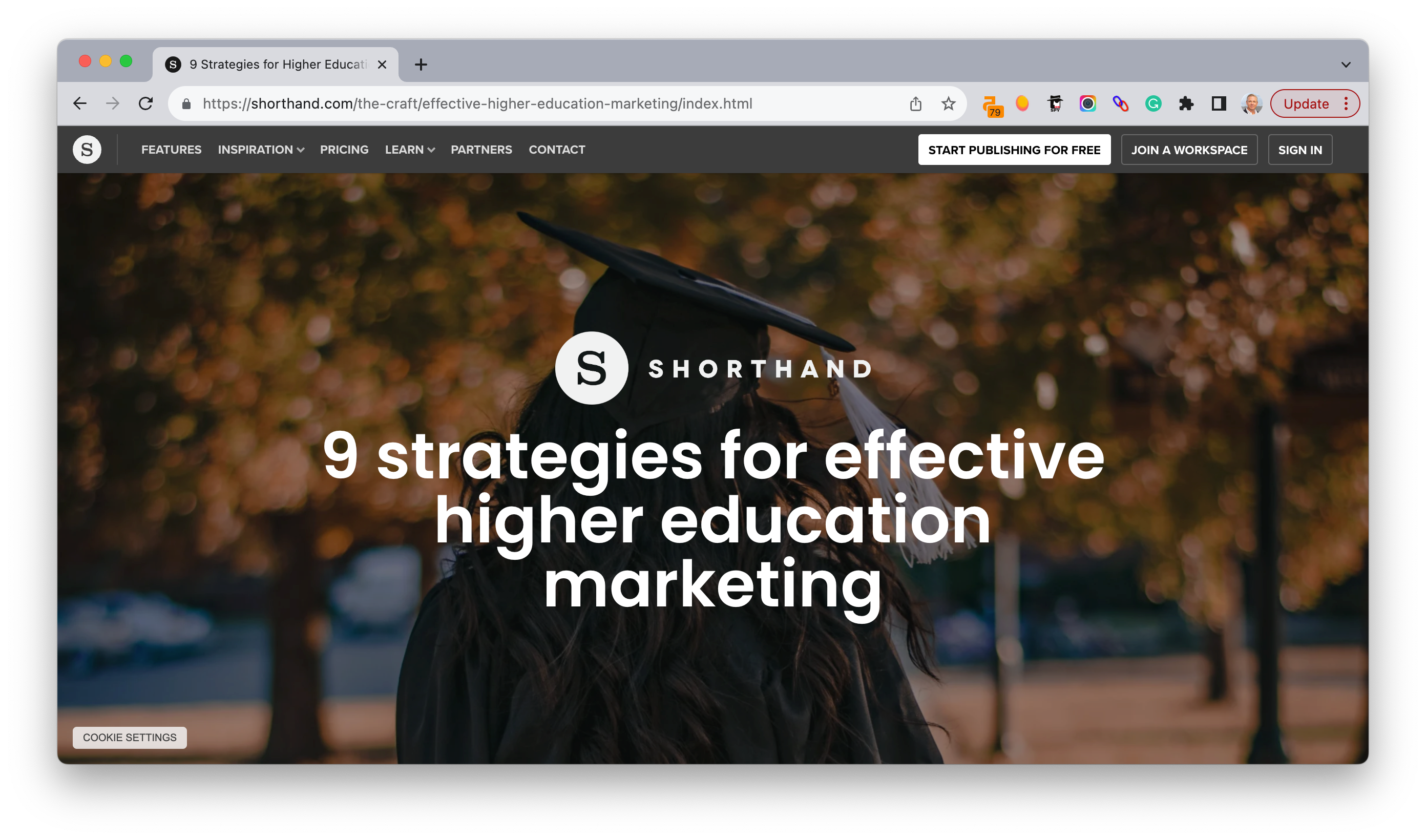
My perspective: OK, I know it’s shallow, but I like the look and feel of this site. It’s got a very medium-esque vibe.
On a more serious note, the authors point out one of my constant refrains: The decentralized nature of a higher education marketing strategy is costing universities dearly. Very few schools have central oversight and are therefore cannibalizing their own messaging and budgets.
The article delves into the complexities of marketing in higher education, highlighting the unique challenges faced by universities. One of the primary challenges is the siloed nature of marketing in universities. While universities typically have a central marketing team focused on boosting student enrollment and driving donations, there are also numerous smaller teams across various academic departments and schools, each with slightly different target audiences.
These smaller teams often work independently on their marketing strategies, employing a wide range of tactics such as social media, SEO, email marketing automation, PPC campaigns, live streaming video content, direct mail, in-person events, and even chatbot scripts. This decentralized approach can lead to several issues:
- Dilution of the Brand: Inconsistent application of messaging and brand guidelines can weaken the overall brand identity.
- Missed Opportunities: Due to weak communication channels, potential marketing opportunities might be overlooked or not fully capitalized upon.
- Decreased Morale: Teams or individuals working in isolation can experience reduced morale.
Despite these challenges, the article offers hope by suggesting nine strategies to promote more cohesive and effective higher education marketing. While the specific strategies aren’t detailed in the provided excerpt, the article emphasizes the importance of cohesive marketing efforts across the institution.
Unique Positions:
- The article highlights the unique challenges higher education institutions face due to the decentralized nature of their marketing efforts.
- It underscores the importance of a unified approach to marketing to ensure consistent branding and messaging.
Noteworthy Mentions:
- The article references recent engagement examples related to the pandemic, suggesting that universities have proactively created content around COVID-19.
- The University of Queensland is highlighted for its digital publication, “Contact,” which offers an engaging and interactive user experience while catering to those who prefer traditional print magazines.
Final Thoughts
As you can see, there are a number of ways to get in front of students for your school.
The consensus seems to be that SEO, social media marketing and advertising, email, and PPC are great ways to invest your marketing dollars.
It’s surprising to see how little attention is paid in the articles to analysis, tracking, and reporting, given how many of the UPCEA Higher Education SEO Study respondents indicate this is lacking.
As management icon Peter Drucker is famously quoted, “What gets measured gets managed.” All the landing pages, tactics, and strategies in the world won’t make us successful if we don’t know what’s working.
For more information about higher education marketing, contact our team at Search Influence today.















